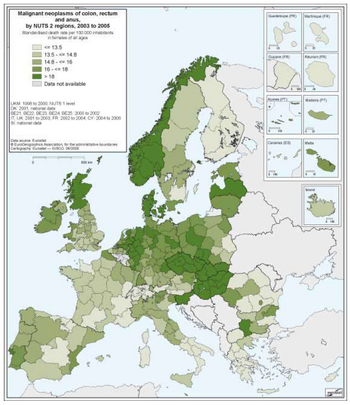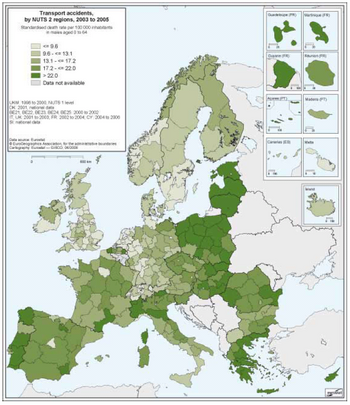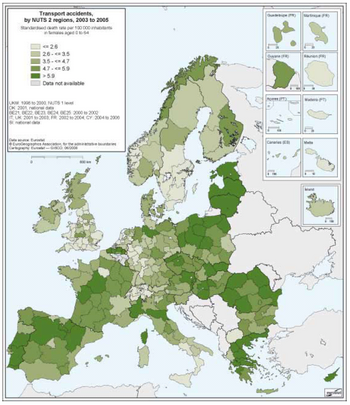- Data from March 2008, most recent data: Further Eurostat information, Main tables and Database.
Death rates, also known as mortality rates, show marked differences according to age and sex, but they also vary between countries and between regions. Most of the new Member States of the European Union (EU), for example, are characterised by high death rates due to diseases of the circulatory system. This article looks more closely at mortality rates in the EU and tries to discern patterns, both at national and at regional levels, distinguishing between men and women and between different age groups.
Two important causes of death are discussed at more length: colorectal or bowel cancer and transport accidents, including road, rail and accidents.
Main statistical findings
Mortality patterns differ significantly according to age and sex, but they also vary between countries and between regions. There are three types of factors that determine mortality patterns:
- intrinsic factors, such as age and sex;
- extrinsic factors, such as biological or social collective factors including living and working conditions;
- individual factors, such as lifestyle, smoking, alcohol consumption, driving and sexual behaviour.
As a general rule, the mortality rate is higher among men than among women in all age groups, meaning men overall die earlier than women born in the same year as them. Although there are signs that the mortality gap is narrowing in some Member States, there are still significant differences between the genders.
Variations in mortality patterns highlight the major difference in causes of death according to the particular age group of the population. Since people tend to live longer nowadays, diseases of the circulatory system are the main cause of death in the EU. Malignant neoplasms (cancers) are the second most frequent cause, affecting mainly the middle-aged and the elderly. At the same time, the largest proportion of deaths in the younger age groups is due to external causes (including transport accidents). The distribution of causes of death also varies according to geographical location: most of the new Member States, for example, are characterised by high death rates due to diseases of the circulatory system, with the Baltic Member States also recording higher mortality from external causes.
For all the reasons mentioned above, it is important to study mortality rates more closely, both at national and at regional levels, distinguishing between men and women and between different age groups.
Colorectal cancer
Colorectal cancer (also called bowel cancer) includes cancerous growths in the colon, rectum and anus and is the second most frequent cause of deaths from cancer in Europe; it accounts for more than one in 10 of all malignant cancer deaths (11.2 %) and for 3 % of all deaths within the EU in the period 2003–2005. Colorectal cancer mainly affects older people, seven out of 10 deaths from colorectal cancer occur after the age of 65 years.
There are considerable gender differences in the patterns of deaths from colorectal cancer within Europe; these are shown in Map 1 (male death rates) and Map 2 (female death rates). The average death rates range from 26 deaths per 100 000 inhabitants for men and 16 deaths per 100 000 inhabitants for women.
Taking all ages together, in almost all cases the male/female mortality ratios for colorectal cancer show higher male mortality in virtually every region, except for Martinique (France), where more female deaths were recorded (11.3 compared with 10.6). For other regions within the EU the variation is relatively small, ranging from close to 1.0 in Åland (Finland) and Sterea Ellada (Greece) to around 2.3 in Principado de Asturias (Spain), País Vasco (Spain) and Stredné Slovensko (Slovakia).
Regional patterns of mortality are less marked however, although some regional particularities are apparent. High mortality rates are seen in the central and east European regions, as well as in Norway and Portugal (2003–2005). Mortality rates were particularly high in Hungary (36.1), the Czech Republic (34.7) and Slovakia (31.4),these figures are on average 77 %, 70 % and 54 % higher than the EU average (20.4). At the other end of the scale are the regions of Finland (13.9), Greece (12.6), and Cyprus (10.1), where mortality from colorectal cancer was the lowest in the EU, with rates respectively 32 %, 38 % and 50 % lower than the EU average.
The number of new cases of colorectal cancer and the number of deaths it causes are decreasing slightly each year. However, the survival rate for such cancers is only 54 %. Although it is impossible to influence some of the risk factors, such as genetic predisposition or ageing, the incidence of colorectal cancer could be lowered by taking preventive measures and reducing these risk factors. For example, there is broad agreement that a higher risk of colorectal cancer is linked to obesity, a diet high in red meat, proteins and fats and high alcohol consumption.
Transport accidents
Regional death rates from transport accidents (which include road, rail and air accidents) mainly reflect the mortality associated with road accidents, which cause by far the greatest number of deaths in the group. Over three quarters of the deaths caused by road accidents affect those under 65 years.
Road traffic accidents form the majority of all transport-related fatalities and are the main cause of mortality in the 15–24 age group in most European regions. Map 3 shows the regional distribution of transport accidents for men and Map 4 likewise for women.
Differences in death rates from transport accidents across Europe are quite large. There were more than than 20 deaths per 100 000 inhabitants in Cyprus, Lithuania and Latvia (2003-2005), while in the Netherlands, Malta and Sweden rates are over five times lower.
Deaths from transport accidents do not affect the whole population evenly. Premature mortality rates due to transport accidents for males are on average 3.7 times higher than for females. Although the male/female mortality ratio may vary significantly between countries, from less than 3 in Cyprus, Iceland and Luxembourg to more than 5 in the former Yugoslav Republic of Macedonia and Malta, in general the pattern for men and women follows the same trend.
When comparing regional rates, the population size and number of vehicles must be taken into account, together with other factors affecting road safety, such as the quality of the roads and driving behaviour.
Analysed by sub-national areas, mortality rates for transport accidents vary considerably across the EU. The regional distribution of premature mortality expressed in standardized death rates (SDR) shows a very clear pattern of European risk areas. The highest SDRs for accidents are found in a more or less continuous area stretching from the Baltic States via Poland, Slovakia, and regions in the Czech Republic, Austria and Hungary through Romania all the way to Greece.
In the southern part of the EU, almost all regions in Portugal and Greece show high SDRs for the period 2003–05, and indeed the highest rates in the EU. The Portuguese provinces of the Algarve and Alantejo rank in second and third place respectively. The lowest mortality rates were found mainly in regions with large urban areas, such as Berlin (3.3), Bremen (3.5) and Hamburg (3.5) in Germany, in Zuid-Holland (with 3.7 for Rotterdam) and Noord-Holland (with 4.3 for Amsterdam) in the Netherlands, Stockholm (3.7) in Sweden, Outer London (4.1) in the United Kingdom, Oslo og Akershus (4.7) in Norway, Zurich (4.9) in Switzerland and Wien (5.3) in Austria.
One possible explanation for these lower rates is the relative reduction in traffic speeds encountered in urban areas. Another is the greater efficiency of the emergency services available to accident victims in towns and cities.
The mortality pattern in many cases follows national borders. In public health terms, transport accidents are arguably the most avoidable cause of loss of productive life — suggesting that there is an important role here for policymakers.
Data sources and availability
Causes of death (COD) statistics are based on information derived from medical death certificates. COD statistics record the underlying cause of death, i.e. ‘the disease or injury which initiated the train of morbid events leading directly to death, or the circumstances of the accident or violence which produced the fatal injury’. This definition has been adopted by the World Health Assembly.
In addition to absolute numbers, crude death rates and standardised death rates for COD are provided at national and regional level. Regional level data are provided in form of three-year averages. The crude death rate describes mortality in relation to the total population. It is expressed per 100 000 inhabitants, being calculated as the number of deaths recorded in the population for a given period divided by the population in the same period and then multiplied by 100 000. Crude death rates are calculated by five-year age groups. At this level of detail, comparisons between countries and regions are meaningful. However, the crude death rate for the total population (all ages) by sex and age is a weighted average of the age-specific mortality rates.
The weighting factor is the age distribution of the population whose mortality is being observed. Thus, the population structure strongly influences this indicator for broad age classes. In a relatively ‘old’ population, there will be more deaths than in a ‘young’ population because mortality is higher in higher age groups. For comparisons, the age effect can be taken into account by using a standard population. The standardised death rate (SDR) is a weighted average of age-specific mortality rates. The weighting factor is the age distribution of a standard reference population. The standard reference population used is the ‘standard European population’ as defined by the World Health Organisation (WHO).
Standardised death rates are expressed per 100 000 inhabitants and calculated for the age group 0–64 (‘premature death’) and for all ages. Causes of death are classified by the 65 causes on the ‘European shortlist’ of causes of death. This shortlist is based on the International Statistical Classification of Diseases and Related Health Problems (ICD), a classification developed and maintained by the WHO.
Context
Health is an important priority for Europeans; they expect to be protected against illness and disease — at home, in the workplace and when travelling. Health is a cross-cutting issue involving a range of topics including consumer protection (food safety), safety in the workplace, and environmental and social policies.
The establishment of EU-wide comparable data on public health and its determinants is closely linked to one of the priorities of the community action programme in the field of public health 2008–13, namely the priority to generate and disseminate health information and knowledge.
It is within this priority area that Eurostat contributes to achieving other objectives of the action programme, by collecting and disseminating statistical data and health indicators, which will help policymakers to identify health risks and improve citizens’ health security and to promote health, including by the reduction of health inequalities.
The provision of information about healthcare systems and, ultimately, about the health of a population is a prerequisite for monitoring the effective performance of public health policy. The currently available regional indicators for health provide an insight into similarities and specificities, as well as into the contrasts that exist throughout the European regions. As shown above, there can be large differences between the regions of a particular country, while regions of other countries may be very similar. Thorough analysis of the trends in, and the variation between, health indicators at regional level is therefore essential. Such analysis is needed for planning and monitoring actions and programmes, formulating new policies and developing new strategies, which together contribute to ‘evidence-based health policy’.
Further Eurostat information
Publications
- Causes of death in the EU - Statistics in focus 10/2006 (available in English, French and German)
Main tables
- Public health
- Main tables
- Public health (t_hlth)
- Causes of death (t_hlth_cdeath)
- Public health (t_hlth)
- Main tables
Database
- Health, see:
- Public health
- Database
- Public health (hlth)
- Causes of death (hlth_cdeath)
- Public health (hlth)
- Database
Dedicated section
- Health, see:
- Public health
External links
- World Health Organisation (WHO)
- DG Health European Partnership for Action against Cancer
- DG Transport Road Safety




